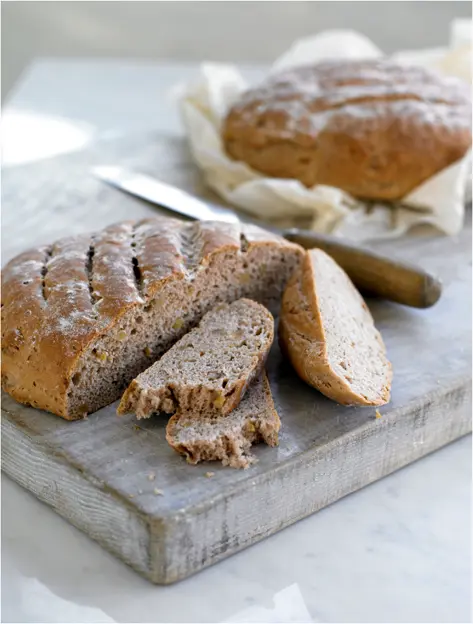Knock the dough back by punching it lightly with a clenched fist, then divide it in half, shaping each piece into a smooth round. Put on baking sheets lined with non-stick baking paper and cover each one with a damp tea towel. Leave to rise again in a warm place for about 30 minutes.
Preheat the oven to 220°C (425°F), gas mark 7. Remove the damp tea towel from the loaves and slash the tops 4-5 times with a sharp knife. Bake for 10 minutes, then reduce the oven temperature to 190°C (375°F), gas mark 5 and bake for another 25-30 minutes, swapping the sheets on the oven shelves halfway through cooking.
When cooked, the loaves should sound hollow if tapped on the bottom. Transfer to a wire rack and allow to cool completely. The bread can be wrapped in cling film and stored in a bread bin for 1-2 days.
To serve, arrange a loaf on a bread board and cut into slices at the table. Serve with butter.

Cheddar & Spring Onion White Soda Bread
This is a delicious variation on a classic Irish recipe. Experiment with other flavourings such as finely chopped sun-dried tomatoes or crispy pieces of smoked bacon. If you don’t have buttermilk, use fresh milk mixed with the juice of a lemon, and leave overnight before using.
 Makes one 15 cm (6in) round loaf
Makes one 15 cm (6in) round loaf
450g (lib) plain flour, plus extra for dusting
1 tsp bicarbonate of soda
l tsp salt
100g (4oz) strong Cheddar, grated
4 spring onions, trimmed and finely chopped
350ml (12fl oz) buttermilk, plus a little extra if necessary
Preheat the oven to 230°C (450°F), gas mark 8. Sift the flour, bicarbonate of soda and salt into a large mixing bowl. Make a well in the centre of the dry ingredients and stir in the Cheddar and spring onions, then add the buttermilk. Using a large spoon, mix gently and quickly until you have achieved a nice soft dough. Add a little bit more buttermilk if necessary until the dough binds together without being sloppy.
Knead the dough very lightly on a lightly floured work surface and shape into a round of roughly 15cm (6in). Place on a non-stick baking sheet and cut a deep cross in the top. Bake for 15 minutes.
Reduce the oven temperature to 200°C (400°F), gas mark 6 and bake the loaf for another 20-25 minutes or until it is evenly golden and crusty. It should sound hollow when tapped on the bottom. If it doesn’t, return to the oven for another 5 minutes.
Transfer the cooked soda bread to a wire rack and allow to cool for about 20 minutes. This bread is best eaten while it is still warm, as it doesn’t store well. To serve, place the soda bread on a bread board and cut into slices at the table.
Variation Brown Soda Bread
Make as above but use 350g (12oz) plain flour mixed with 100g (4oz) coarse, stoneground wholemeal flour. Add 2 tablespoons of pinhead oatmeal to the mix before adding the buttermilk.
Red Onion, Olive & Rosemary Focaccia
This savoury Italian bread is made much like pizza. Semi sun-dried tomatoes or strips of roasted peppers also work well on top. This dough can be made even more easily in a food mixer.
 Makes one 28 x 18cm (11 x 7in) loaf
Makes one 28 x 18cm (11 x 7in) loaf
7 tbsp extra-virgin olive oil, plus extra for oiling and drizzling
1 tsp easy blend dried yeast
450g (1lb) strong plain white flour, plus extra for dusting
1¼ tsp sea salt
1 large red onion, halved and cut into slices (keep them attached at the root)
100g (4oz) pitted black olives
1 sprig of rosemary, leaves stripped
salt and black pepper
Oil a 28 x 18 x 4cm (11 x 7 x 1½in) baking tin and line with nonstick baking paper. Mix the yeast, flour and ½ teaspoon of salt in a large mixing bowl. Make a well in the centre and pour in 225ml (8fl oz) lukewarm water and 5 tablespoons of olive oil. Mix well to form a soft dough, then turn out on to a lightly floured work surface and knead for 10 minutes until smooth and elastic. Place in an oiled mixing bowl, cover with oiled cling film and leave to rise in a warm place for about 1 hour or until doubled in size.
Turn the dough out on to a lightly floured surface and knock it back, punching lightly to knock out air bubbles, then knead for another 2-3 minutes. Roll out to a large rectangle about 1cm (½in) in thickness. Place in the prepared tin. Cover with oiled cling film and leave to rise again for 30 minutes – it should look soft and pillowy.
Meanwhile, preheat the oven to 220°C (425°F), gas mark 7. Heat 1 tablespoon of the olive oil in a small roasting tin and toss in the red onion. Season with salt and pepper and spread in an even layer, then roast for 15-20 minutes until just tender but not coloured.
Prick the risen dough all over with a fork. Stud with the olives, fan out the red onions on top, then scatter with the rosemary and the rest of the salt, and drizzle with the remaining olive oil. Bake for about 30 minutes until risen, cooked through and golden brown. Don’t worry that the onions will have tinged at the edges.
Leave in the tin for a few minutes, then turn out on to a wire rack to cool and drizzle with a little extra olive oil to keep the crust soft. Cut into chunks to serve. This is best served warm but also reheats well in a low oven or is fine when cold. To store, allow to cool, wrap in cling film and store in a bread bin for 1-2 days.
Tomato & Parmesan Twister Bread Rolls
Makes 24 rolls
For the dough
1 tbsp olive oil, plus extra for oiling
350g (12oz) strong plain bread flour, plus extra for dusting
1 tsp salt
7g sachet of easy blend dried yeast 1 egg beaten with 1 tbsp milk
For the filling
200g (7oz) Tomato Sauce (see page 214)
125g (4½oz) Pesto (see page 208)
75g (3oz) freshly grated Parmesan cheese
These bread rolls are easy to make and taste so much better than any you can buy in the shops. You can vary the fillings – try sun-dried tomato paste, tapenade, red onion marmalade, finely chopped sun-dried tomatoes or different cheeses – but go light on them or the fillings may burn while they are cooking. Turn the page for step-by-step pictures.
Preheat the oven to 200°C (400°F), gas mark 6. Lightly oil two 12-hole muffin tins.
Sift the flour into a large mixing bowl with the salt and stir in the dried yeast. Make a well in the centre and pour in the olive oil and 300ml (11fl oz) lukewarm water. Mix to a smooth dough.
Turn the dough out on to a lightly floured work surface and knead for 5-10 minutes, pushing and stretching the dough until smooth and elastic. Alternatively, use a food mixer with the dough hook attached and set on a low speed.
Place the dough in a large, lightly oiled bowl. Cover with a clean tea towel and leave in a warm place for 1 hour until the dough has almost doubled in size.
Knock the risen dough back, punching it lightly to knock out large air bubbles and knead it briefly on a lightly floured work surface. With a rolling pin, roll out the dough into a large rectangle, approximately 55 x 35cm (22 x 14in). Using a palette knife, spread over the tomato sauce and then spread the pesto on top. Sprinkle over the Parmesan cheese. Then, starting from one of the long edges, gently roll the dough away from you into a long Swiss roll shape. Don’t worry if it sticks a little, just gently coax it up a bit at a time with floured fingers until it reaches the other side and then press the seam together to stick. »
Читать дальше


 Makes one 15 cm (6in) round loaf
Makes one 15 cm (6in) round loaf Makes one 28 x 18cm (11 x 7in) loaf
Makes one 28 x 18cm (11 x 7in) loaf










